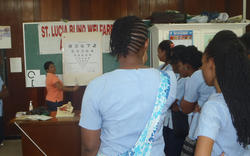Make the world accessible to everyone

Eye conditions are described in terms of condition, disability, and barrier
Firstly one need to know what the problem is….what organ is affected?
What is the disability means what function is affected?
Barrier refers to the limitations set by the disability.
For example: if you have presbyopia (the normal loss of turgidity in the lens usually occurring after the age of 40) the disability is difficulty with near vision (reading). The barrier is an inability to read the bible/or the newspaper/or text…or whatever the task is that you need to accomplish using your near vision.
In many situations the barrier to disabilities due to vision problems is completely outside the realm of the condition…the barrier is society…the barrier is US.
A totally blind person may not be able to cross the street …not because they cannot see the street…but because vehicles refuse to stop to allow them to pass…or persons do not think to offer to guide them…or persons do not think to explain where the crosswalk is. One does not need to ‘see’ to walk…one need to know the way so they can ‘find’ their way (using mobility canes or sighted guides)
A person with low vision may not be able to write a cheque at the bank because there are no large print cheques…or dark felt pens…or signature guides available for them to be able to see what they are writing and sign their names.
WE, society, are to blame for much of the problems in access for persons living with blindness and low vision.
This barrier also affects the workplace. In many situations, the work tasks demanded can easily be performed by a person with blindness or low vision. They only need an environment that is all-inclusive so they can access the information necessary for them to perform the task.
Look around you at all our service centres. Are they accessible for all? Are there ramps for those using wheelchairs? Are signs printed in BIG BOLD letters so persons with diminished vision can read them?
The next time you enter a bank, or bus stand, or public service centre…observe your environment and notice how user-friendly it is? The environment not only includes the physical make-up (lighting, space, large print signs) but also the attitude of the workers. Professionals working in a public service department should be trained to know what the ‘special’ needs of their clients are….and how to help them. Personnel need to be trained to offer ‘service with dignity and respect rather than pity or distaste.
